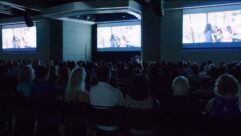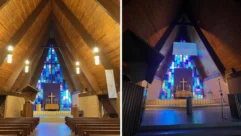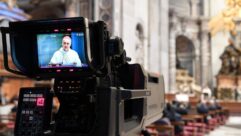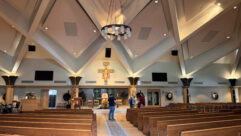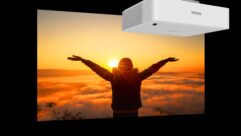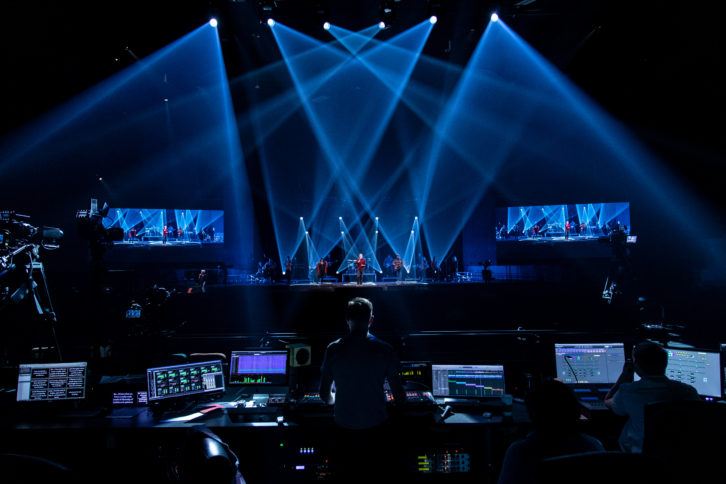
IMAG and streaming have been part of worship for some time now. There is still much to be learned and evolved technically. However, increasingly large-format video display is entering a new era of aesthetic creativity and visual communication. Technology that has been supporting high-impact content to other markets finds application in worship environments too. Visuals speak powerfully to congregations, especially to worshipers raised on video as a first language.
Flatirons Community Church in Lafayette, CO, ranked by Outreach magazine as the 11th largest church in the United States. With its main broadcast campus in Lafayette, Colorado, Flatirons regularly sees more than 18,000 attendees per weekend over its five campuses, plus online live broadcasts on Facebook and YouTube. The church’s satellite sites are located in Denver, Aurora, Longmont, and Golden.
Robb MacTavish, the church’s live production director, says the goal of a recent video overhaul was more cinematic worship experiences for their live services.
Flatirons’ 168,000 square foot Lafayette venue houses the main auditorium, which can hold 4,300 people, plus overflow in the lobby of up to 2,000 people. This location’s 9 a.m. and 11 a.m. Sunday worship services are broadcast live to satellite campuses, social media platforms and the church’s web site.
Typical weekend services feature modern worship music, alongside a Biblically-based spoken message. The music is not limited to conventional worship songs, but includes secular songs by popular bands such as Imagine Dragons, Foo Fighters, Muse, Coldplay and more.
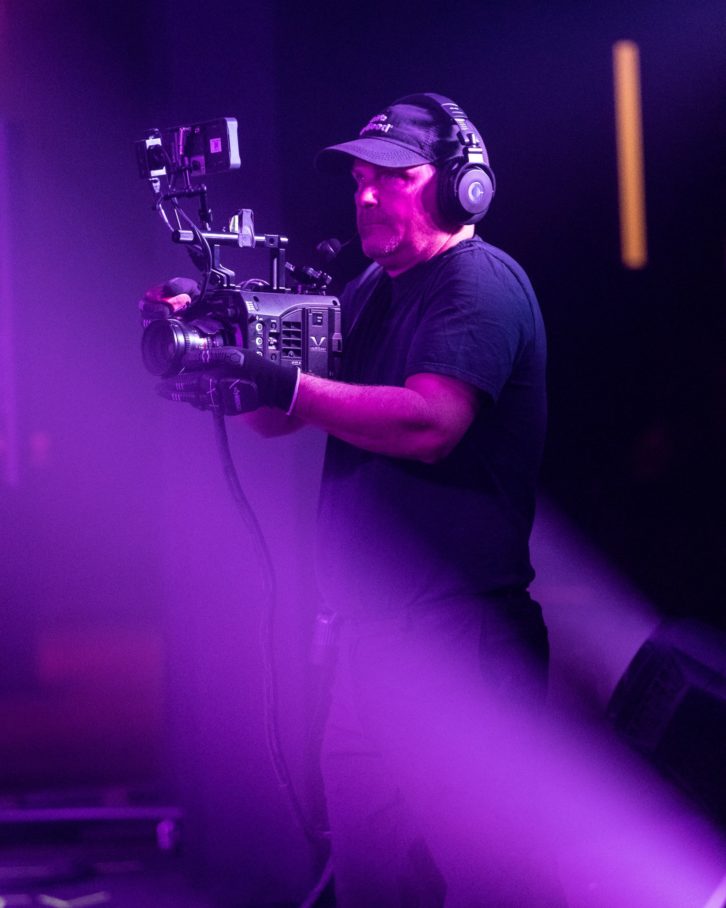 In partnership with Summit Integrated Systems, the church invested in a total of seven Panasonic VariCam LTs and two AU-EVA1 5.7K handheld cameras in a large-scale replacement of their video system.
In partnership with Summit Integrated Systems, the church invested in a total of seven Panasonic VariCam LTs and two AU-EVA1 5.7K handheld cameras in a large-scale replacement of their video system.
“Flatirons is proud of its legacy of cinema cameras being used in live production, which dates back to 2013,” MacTavish said. “A main driver behind our investment in the VariCam LTs was the requirement for minimal latency due to a switch from projection to ROE LED displays for IMAG, which added about two frames of latency into our new 1080/59.94p workflow. With the new setup, we’re only experiencing four frames of latency end-to-end (two frames from our cameras and two frames from our LED displays).”
“We also utilize the ability to switch frame rates in-camera,” he continued, noting that worship productions deploy the 1080/59.94p format for a more lifelike teaching experience, with an effortless switch to 23.98p for a filmic rendition of musical performances.
MacTavish added that teaming the VariCam LTs with Panasonic’s AK-HRP1000 Remote Operating Panels “puts professional grade, tactile control of the cameras in the hands of our shaders, allowing camera operators to concentrate on shot composition and movement.”
The VariCam LT and AK-HRP1000 combination is referred to as CineLive and allows complete control and shading of the camera from the control room. Through an Ethernet connection, the HRP1000 interfaces with the VariCam LT to adjust the camera’s menus and imaging controls. Production-style LUTs and CDLs can be used, or broadcast-style RGB controls for live grading. Scene Files can be utilized for presets and quick switching of modes and looks, including switching between sensor frame rates for different looks. The CineLive system allows multiple outputs from the VariCam camera so that the camera operator can view a display with focus tools while an engineer sees menu controls and a clean image is fed to a switcher for live output. The CineLive system can output in 4K or HD and also record a 4K or HD signal internally for later use. The internal recording can be color graded to match the live output or left “flat” for later adjustment. A 4K image can be recorded while an HD live signal is output, allowing for future archive use. Remote record, tally, callback and return video features allow the engineer at the HRP1000 to communicate with the camera operator at the VariCam LT.
While the CineLive system is capable of 4K internal recording and live HD output, Flatirons currently utilizes the 1080p output to interface with two 24’ by 12’ LED screens and broadcasting services. MacTavish anticipates a future upgrade to 1080/59.94p HDR production.
“Also,” he says, “we make extensive use of the ‘dirty’ feed out of the camera to relay on-screen menu detail to our shader positions, with a clean feed going to the switcher.”
In terms of VariCam LTs’ placement in the main auditorium, Camera 1 is a locked down stage-wide shot, Camera 2 is on the center line 78’ from the stage, Camera 3 is a slash camera used for angle shots from Front of House right, Cameras 4 and 5 are placed approximately 24’ from the stage for angle shots from the left and right, and Cameras 6 and 7 are used handheld on stage left and right for close-ups of musicians and instruments. One AU-EVA1 is used on a 21’ dolly track at Front of House, and the second is used on a jib that is placed in various locations throughout the auditorium.
The VariCam LTs are outfitted with Fujinon Cabrio S35 lenses, including the XK6x20 (T3.5/20-120mm), ZK12x25 (T3.5/25-300mm) and ZK3.5×85 (T2.9-4.0/85-300mm) models, as well as Sigma 120- 300mm f/2.8 lenses and (for the LTs used handheld) a selection of Rokinon 35, 50, and 85mm prime lenses, and the Canon 24-70mm f/2.8L II USM lens. The AU-EVA1s use Canon 70-200mm f/2.8L IS II USM (dolly) and Canon 16-35mm f/2.8L II USM (jib) lenses.
MacTavish said that the AU-EVA1s were providing cost-efficient capture of wider shots, with ease-of-use for operators and versatile iPad control for live shading.
MacTavish supervises four full-time staff, who oversee all aspects of the live weekend worship experience (except audio). “However, 98% of our operators are volunteers, and training on these latest Panasonic cameras was simple.”
For First Assembly of God, a Pentecostal ministry established 47 years ago in Fort Myers, FL, the goal was to move away from a traditional CCD broadcast look. “We wanted something modern, with a full 35mm sensor, fiber capabilities, studio viewfinders and a form factor for lenses,” says Tod Cole Media Director, First Assembly Ministries
The church also chose the Panasonic VariCam LT cameras with CineLive, as well as AW-UE150 4K/HD pan/tilt/zoom cameras, for live production of weekly worship services
The cameras are also used to produce eight weekly television programs, one of which, “Celebration under the Silverdome,” airs nationally on the CTN network, which is carried on DirecTV and the Dish Network.
First Assembly’s ministry reaches over 6,000 weekly attendees throughout its 25-acre campus, as well as a growing online and TV audience. Three weekend and one weekday service are streamed live on YouTube Live and Facebook Live, as well as on the church’s website. The Panasonic cameras are likewise utilized for IMAG projection in First Assembly’s main sanctuary, and local television station WRXY-TV streams from the sanctuary for its ”Living as One” program. First Assembly archives its video feeds on Vimeo.
Cole explained that three VariCam LTs are positioned throughout the church’s sanctuary, one on a jib, the second in the center, and the third placed at a right angle. One AW-UE150 PTZ is mounted high in the sanctuary to pan left to right for audience reactions, with a second placed on stage for extreme close-ups.
The VariCam LTs are outfitted with Fujinon Cabrio S35 lenses, including the ZK12x25 (25-300) and ZK3.5×85 (85-300) models. Using a DTS fiber system, the VariCam LTs are connected to the control room, where they are connected to Panasonic AK-HRP1000 Remote Operating Panels for the CineLive system. While the CineLive system is capable of internal recording and 4K output, First Assembly is mostly utilizing an HD output to interface with its 20’ by 20’ screens and live streaming services.
Cole said that, with 4K projector purchases imminent, he anticipates transitioning to UHD production within six months, and full 4K production within a year.
“When we’re shooting under full stage lights, we deploy ISO800 for an amazing look. In low light, we bump up to ISO5000,” Cole says. The ability to blur the depth of field is so eye-catching—the congregation’s response to the new production values has been, ‘How is this possibly the same church?’”
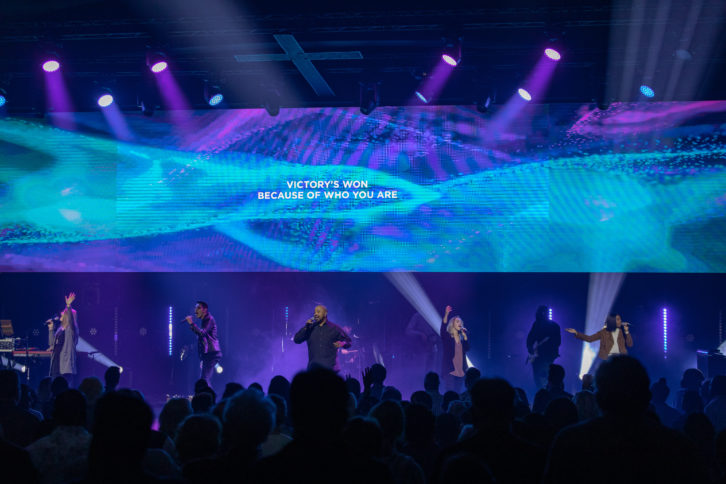 As it is for many churches, for Life Church and its four satellite campuses in Memphis, Tenn. it was important to live stream its services from the main campus to the satellite location. Brian Pitre, Life Church’s Creative Director says the team spent years searching for the right streaming solution and ultimately chose VITEC’s MGW Ace Encoder and Decoder. A part of VITEC’s Houses of Worship Solution, it supported the church’s requirement to record a high-quality broadcast video from the main location and stream it live to multiple satellite locations simultaneously without errors and with delayed playback.
As it is for many churches, for Life Church and its four satellite campuses in Memphis, Tenn. it was important to live stream its services from the main campus to the satellite location. Brian Pitre, Life Church’s Creative Director says the team spent years searching for the right streaming solution and ultimately chose VITEC’s MGW Ace Encoder and Decoder. A part of VITEC’s Houses of Worship Solution, it supported the church’s requirement to record a high-quality broadcast video from the main location and stream it live to multiple satellite locations simultaneously without errors and with delayed playback.
VITEC aggregated its decades of experience with signage, IPTV, point-to-point streaming, remote production, and archiving into a formal Houses of Worship Solution.
The solution uses HEVC encoding technology and VITEC’s Zixi streaming protocol to transmit multiple independent IP streams over existing IP infrastructure. The MGW Ace Encoder and Decoder supports both HEVC and H.264; its 4K-capable FPGA architecture ensures multisite live streaming on private or public networks. When paired with MGW Ace Encoder, the set becomes an end-to-end streaming solution that affordably transmits bandwidth-efficient, artifact-free, timesynchronized video and playback that meet the demands for streamed worship services.
Another factor that played into Life Church’s decision was the integration of VITEC’s house of worship streaming solution with Renewed Vision ProVideoServer (PVS), a four-channel HD video server from one of the most trusted technology providers in the worship space. PVS enhances the VITEC system with recording, playback, and time-slip capabilities.
This combination allows Life Church to easily record its high-quality broadcast stream with embedded timecode and multichannel audio and play it back with the necessary delay at each of the satellite campuses at any time, even as it records.
The volunteer staff doesn’t have to worry about glitches disrupting the service or relying on previously recorded services to fill the slot. They can focus on one live message that is shared with the entire Life Church family.


